Setting up your website is the first step to taking your business online. To set up a professional-looking website, it is important to choose a custom domain name and the right type of web hosting. Once your website is up and running, you can monetize it by running ads on it. One of the most popular ways to monetize your website is using Google AdSense.
What is Google AdSense?
Google AdSense is a platform by Google that lets you run simple, free and flexible ads on your website. The platform enables you to easily earn money from your website by placing engaging ads.
In this tutorial, we will walk you through how to add Google AdSense code to your WordPress website. Let’s get going!
There are two ways of adding Google AdSense to your website viz. manually and automatically. We will cover both these methods in the succeeding sections.
Adding Google AdSense Ads Manually
Step 1: Go to the Google AdSense website
The first step to setting up a Google AdSense campaign is to set up your Google AdSense account.
- Go to the Google AdSense website
- Click on ‘Get Started’
- Enter your website URL and either your business email address or your @gmail.com/yahoo.com/outlook.com to start the sign up process
- Next, re-enter your website URL, select your country, and click on the ‘I accept’ after reading the terms and conditions
- Next, click on the ‘Create Account’ button to complete the signup process.
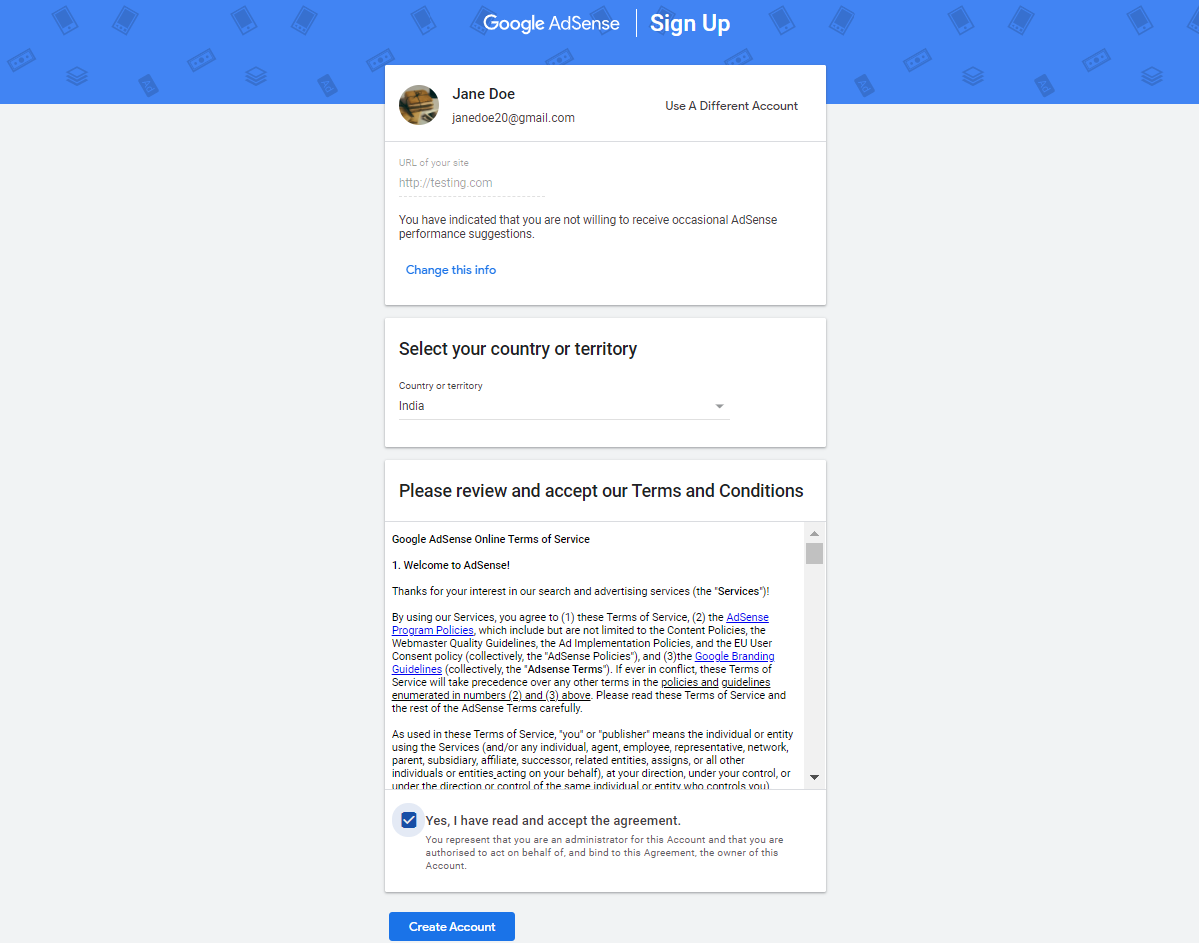
Step 2: Setting Up Your Ad to Be Posted on Your Website
After clicking on the ‘Create Account’ button, your AdSense account will be created, and you’ll be redirected to the Google AdSense dashboard. Here you can manage your AdSense account as per your requirements.
Let us start by creating your first ad.
1. Click on the ‘Ads’ menu on the left-hand sidebar
2. Now, an overview window with three tabs will appear viz. ‘By site’, ‘By ad unit’ and ‘Global settings’
3. Switch to the ‘By ad unit’ tab and click on ‘Display ads’ the recommended way of creating a new ad unit
Note: If you are well versed with ads, then you can select any of the ads mentioned. However, for a beginner, Display ads are a good starting point.
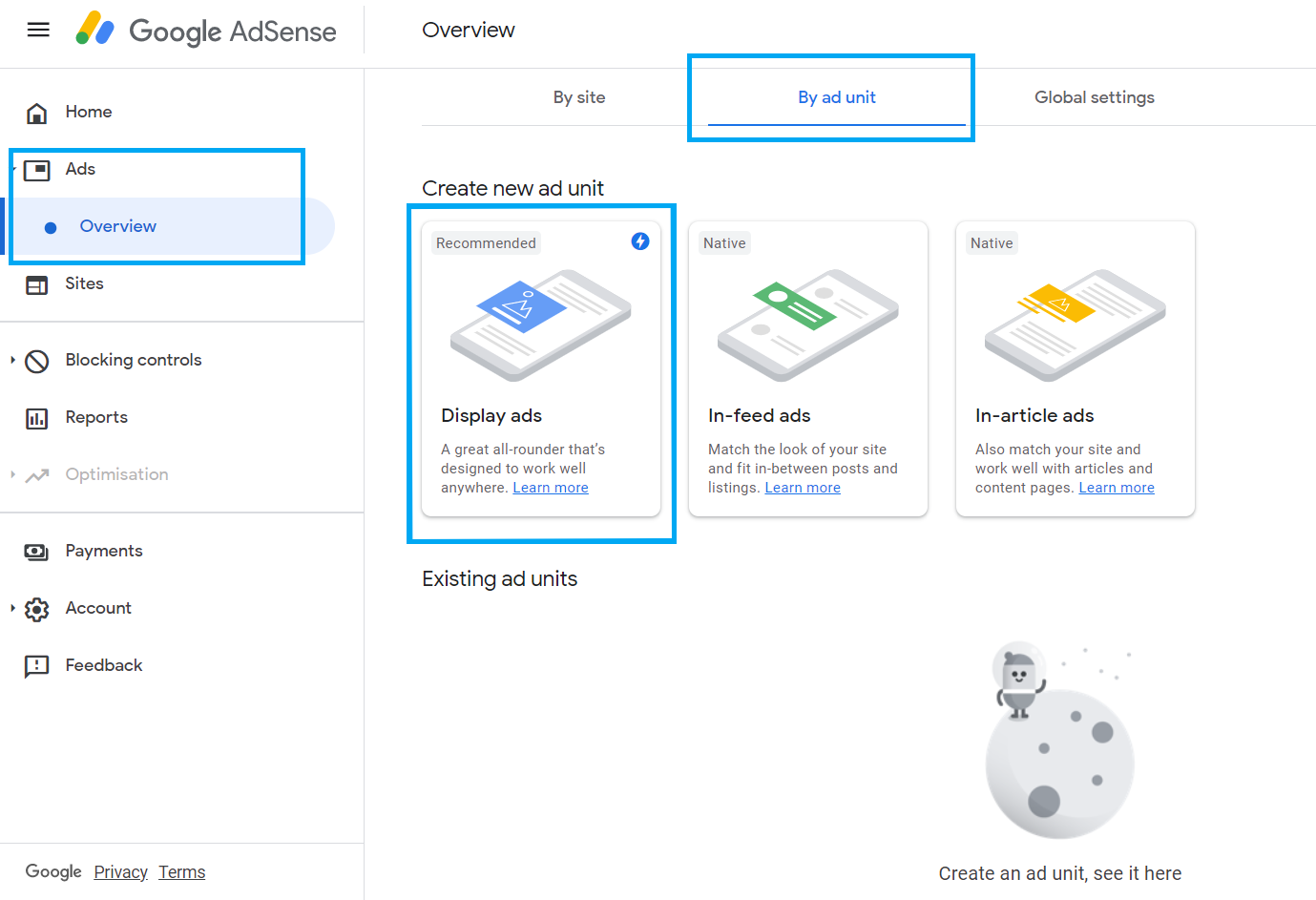
4. The next step is to name your ad and specify the size. Once you double-click the ‘Display ads’ image the following pop-up window will appear.
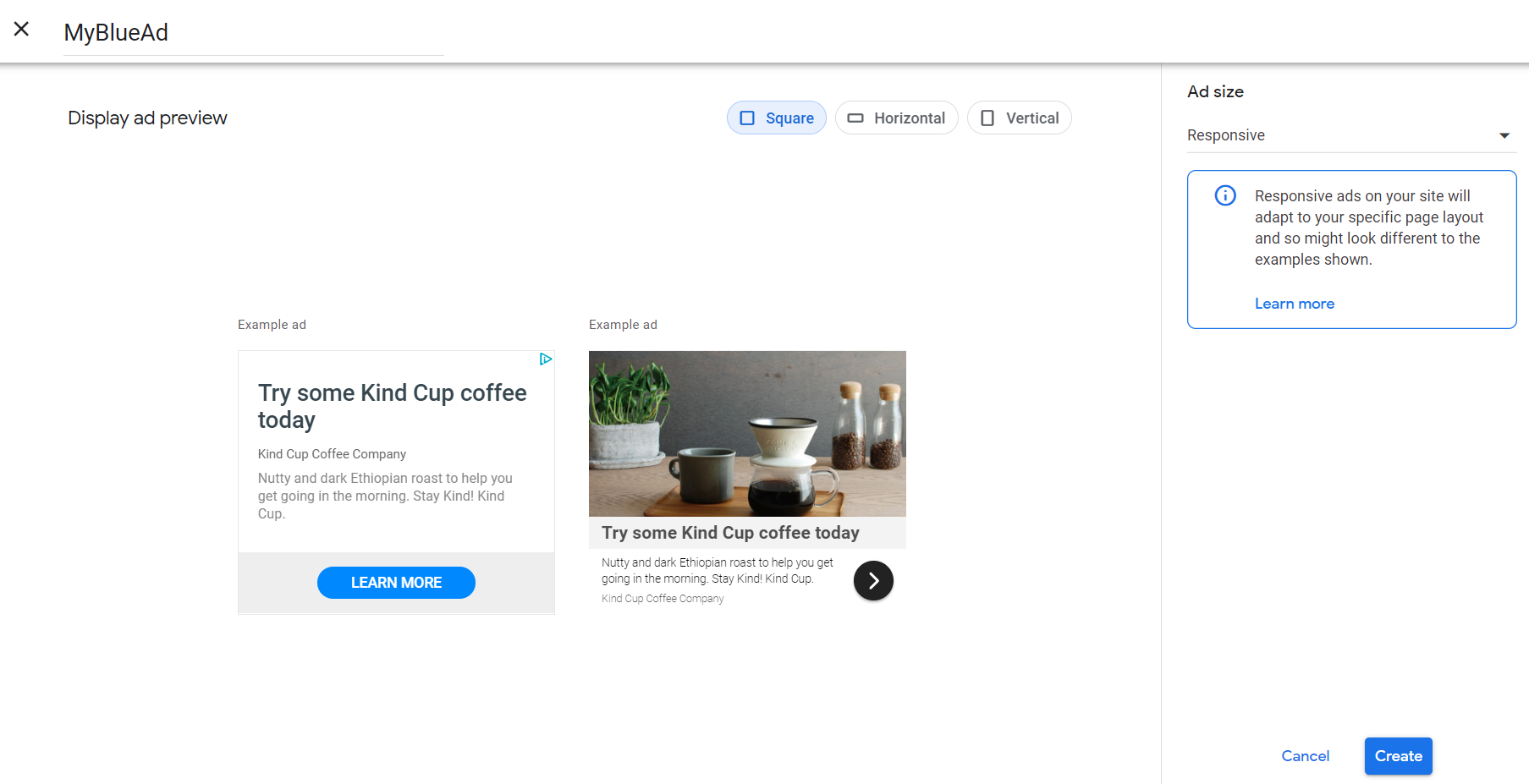
5. Name your ad in the text box that displays ‘Name your ad unit’. Here, ‘MyBlueAd’ is the name of our ad. You can also preview the ad if you wish
6. Next, you need to specify the size of your ad. There are two parameters you can choose from ‘Responsive’ and ‘Fixed’. It is recommended to go with a responsive ad as it automatically adjusts itself depending on the web page layout. However, if you wish you can specify a fixed size too.
7. After you’re done with these two steps, click on the ‘Create’ button
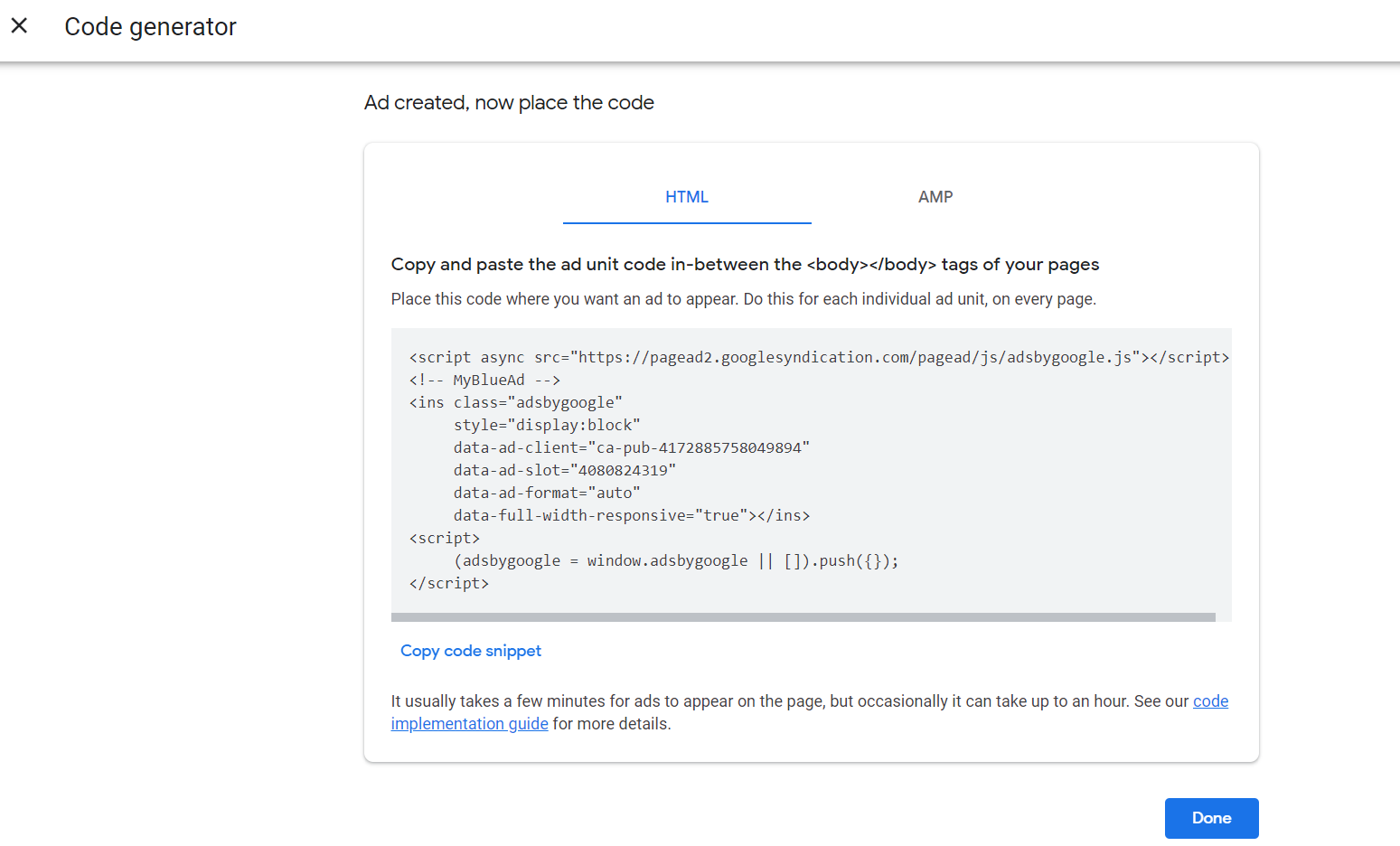
8. Post clicking the create button, Google AdSense creates a unique ‘ad code’ in two formats viz. HTML and AMP. This code contains your unique ad unit ID and publisher ID.
9. Copy and paste the code in your Notepad, as it will be required for step 3.
Step 3: Adding Google AdSense to your WordPress
Once you are done generating the code for your ad, it is time to add it to your WordPress site. For adding a custom code to your WordPress backend, you need to insert it through a widget.
Follow these instructions:
1. Log in to your WordPress dashboard
2. Go to the ‘Appearance’ tab on the left-hand side sidebar
3. Click on ‘Widgets’ from the list and a new page will open
4. Here select the ‘Custom HTML’ widget. Drag and drop this widget where you want to place your ad in the proper widget area
5. Paste the Google AdSense code of your ad there
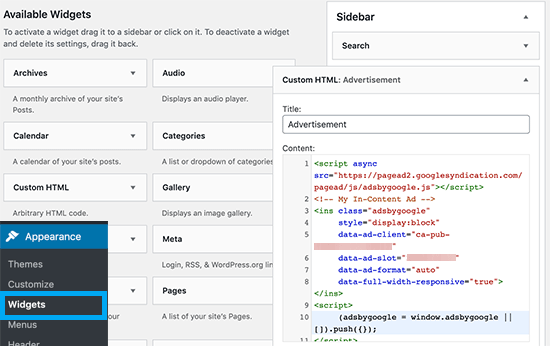
Adding Google AdSense Ads Automatically
If you’re a beginner and do not know much about ads, Google has this simplified for you. Instead of manually creating an ad from scratch, you can directly copy an ad code that Google provides to your site.
Although there is one disadvantage to adding Google AdSense Ads automatically, unlike manual ads you can’t control where your ads are placed on your website. However, apart from the placement, your ad works perfectly fine. Let us see how you can auto-add ads to your WordPress account.
1. Click on the ‘Ads’ menu on the left-hand sidebar
2. Now, an overview window with three tabs will appear viz. ‘By site’, ‘By ad unit’ and ‘Global settings’
3. Go to the ‘By site’ tab and click on ‘Get Code’
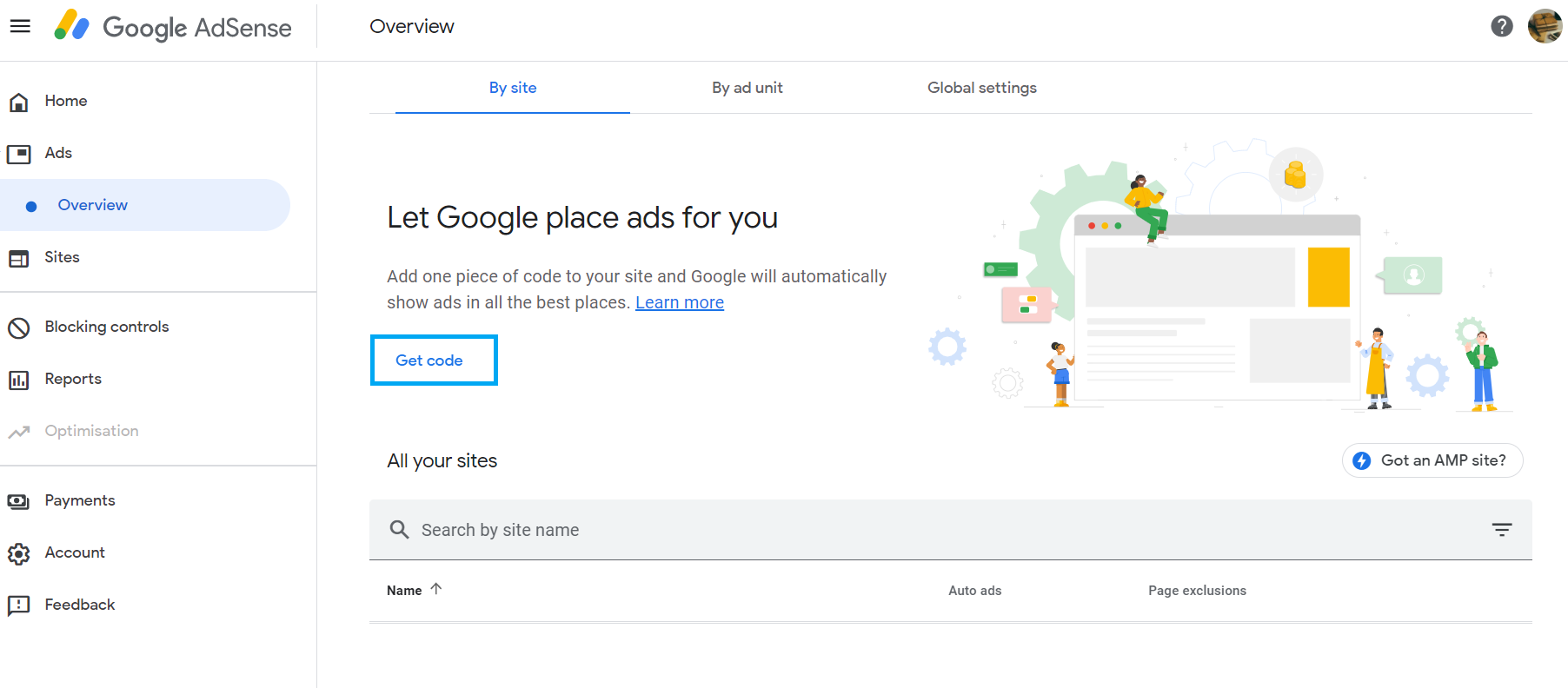
4. After clicking on ‘Get Code’ a pop-up window will open with AdSense code. Copy this code for future reference on your Notepad.
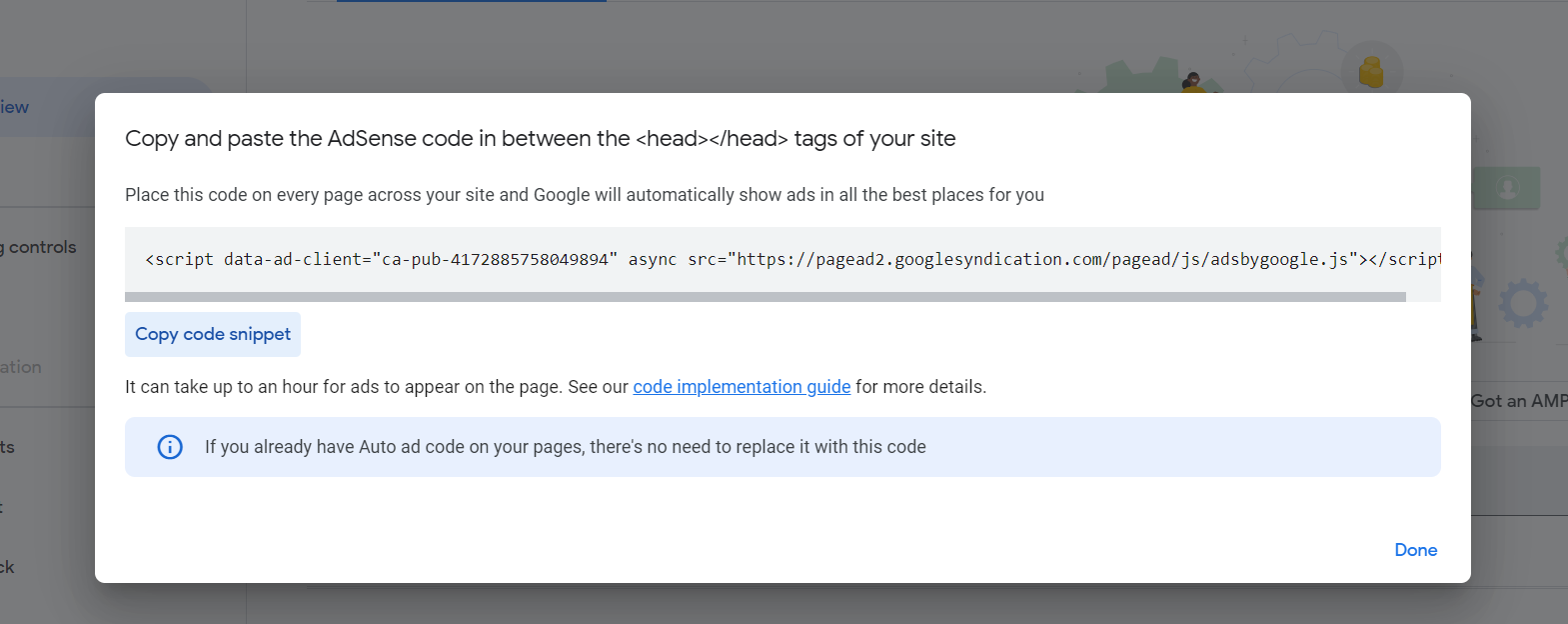
5. Log in to your WordPress dashboard.
6. Go to the header.php file (this file is found in your website’s theme) and paste the copied code here.
However, it is best not to make changes to your header.php file if you aren’t well-versed in coding as an error with this file can disrupt your website. A simpler way is to paste the code using a plugin. Some of the suggested plugins are Insert Headers and Footers, Woody code snippets, and more.
7. After inserting the code in the plugin, click ‘Save’ so that the ad can appear on all pages of your WordPress website.
Now that you’ve learnt what Google AdSense is and how to add Google AdSense to WordPress (automatically as well as manually), let’s understand the benefits of Google AdSense.
Benefits of Adding Google AdSense to Your WordPress Site
Adding Google AdSense to your WordPress website can generate additional income by displaying targeted ads to your visitors. It’s an effortless way to monetize your website, diversify revenue streams, and maximize traffic potential.
Let’s understand the benefits in detail.
-
Starting out is simple
Signing up for Google AdSense is a straightforward process. With a Google account, you can easily register, place the AdSense code on your site, and start earning once approved (usually within 24-48 hours, unless your site violates guidelines).
-
Complete quality control
Google AdSense is highly valued by brands and advertisers due to its stringent quality control measures for publisher websites. In order to qualify as an AdSense publisher, your website must exhibit original, accurate, and high-quality content.
AdSense moderators promptly reject websites that fail to meet these standards, particularly those operating in industries like gambling and pornography.
-
Extremely relevant ads
Initially, AdSense used to display ads based on on-page content. However, eventually, it has evolved into an intelligent platform that tailors ads to visitors’ interests and search behaviour. This personalized approach increases the likelihood of ad clicks, ultimately boosting your earnings.
-
Support for various niche
Google AdSense offers monetization opportunities for publishers in various niches (excluding porn and gambling) due to its extensive pool of advertisers, enabling them to generate revenue from their websites.
-
Highly scalable
When you add Google AdSense to your WordPress website, the earning potential becomes limitless. Increased content publication and site traffic directly correlate to higher revenue through clicks on Google AdSense units displayed on your site.
-
Attractive PPC
As an AdSense publisher, you can earn between $0.2 and $15 per click, although most niches typically yield $1-3 per click.
Advertise to Monetize
Google AdSense is one of the most effective ways to monetize your website. We hope this article helped you understand the Google AdSense platform and how to use it to add ads to your WordPress site.
So, what are you waiting for? Go, get started on adding a Google AdSense code to your website to advertise ads and monetize it to make a profit!
For more information, head to the WordPress Tutorials page and browse through a large repository of helpful resources and blogs.



